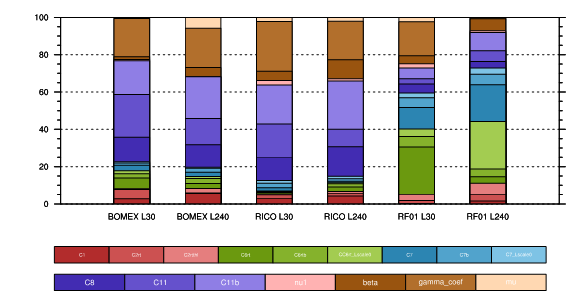The Most Influential and Uncertain Processes in Simulating Low-cloud: Based on a Higher Order Closure Scheme
Date:2015-09-06
Cloud is one of the most uncertain atmospheric components in simulation because it relates to numerous complex sub-grid physical processes, such as turbulence, convections, microphysics etc. In most general circulation models, they are treated by separate and independent parameterizations that will produce unrealistic results when cloud regimes evolve and interact. Therefore, a unified scheme, which can handle multiple processes (e.g. boundary layer turbulence and convections, etc.), is necessary and frontier in the climate modeling.
Recently, under the collaboration of the Institute of Atmospheric Physics, Pacific Northwest National Laboratory, University of Wisconsin-Milwaukee, and National Center for Atmospheric Research, a series of studies using a unified higher order closure scheme (named Cloud Layers Unified By Binormals) have revealed the most influential processes (parameters) in simulating low-clouds.

Fig. 1 The relative contributions of individual parameters to the overall cloud fraction variations in the 16-parameter experiments from two shallow convection cases (BOMEX averaged over hours 5-6 and RICO averaged over hours 7-8) and one stratocumulus case (DYCOMSII RF01 averaged over hours 3-4) at low (30 vertical layers, L30) and high (240 vertical layers, L240) resolutions. (Guo et al, 2014)
These studies found that the dynamic and thermodynamic turbulent structures are the most influential processes for simulating clouds which show clear cloud-regime dependence. For example, stratocumulus is more likely determined by vertical turbulent water and heat flux, while the shallow cumulus mainly relies on the skewness of sub-grid dynamic turbulent structure. Moreover, beside the macrophysics, the dissipation of the total water variance largely affects the variance of in-cloud cloud water, which further influences microphysical process rates (e.g. autoconversion, accretion, and immersion freezing etc.) and eventually the low-clouds. The results largely improve our understanding of higher order closure schemes behavior in simulation of low-clouds and provide valuable insights for the interaction of cloud macrophysics and microphysics. These studies further provide a thorough grounding in the improvements of higher order schemes and climate modeling.

Fig. 2 Different cloud regimes have different influential sprocesses in the transition from stratocumulus to cumulus. The numbers in each plot represent the contribution (%) of each parameter perturbation to the varaince of low-cloud fraction in three different cloud regimes. (Guo et al, 2015)
Recent papers have been published in Journal of Advances in Modeling Earth Systems (DOI:10.1002/2014MS000405; DOI:10.1002/2014MS000315). The studies have also been highlighted by Climate and Environmental Science Division, U.S. Department of Energy, see blew:
Research Team: Zhun Guo, Tianjun Zhou, Institute of Atmospheric Physics;
Minghuai Wang, Yun Qian, Steve Ghan, Mikhail Ovchinnikov, Chun Zhao and Guang Lin, Pacific Northwest National Laboratory;
Vincent E. Larson, University of Wisconsin-Milwaukee; Peter A. Bogenschutz, National Center for Atmospheric Research
Reference:
Guo, Z., M. Wang, Y. Qian, V. Larson, S. Ghan, P. Bogenschutz, A. Gettelman and T. Zhou: Parametric behaviors of CLUBB in simulation of low clouds in the Community Atmosphere Model CAM5, Journal of Advances in Modeling Earth Systems, 7, doi:10.1002/2014MS000405, 2015.
Guo, Z, M. Wang, Y. Qian, V. Larson, P. Bogenschutz, G. Lin, S. Ghan, M. Ovchinnikov, C. Zhao, and T. Zhou: A sensitivity analysis of cloud properties to CLUBB parameters in the Single Column Community Atmosphere Model (SCAM5), Journal of Advances in Modeling Earth Systems, 6, doi:10.1002/2014MS000315, 2014.
Contact: Dr. GUO Zhun, guozhun@lasg.iap.ac.cn
